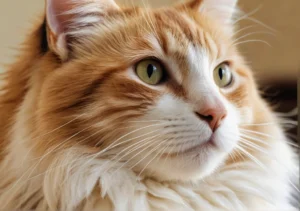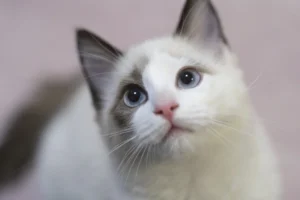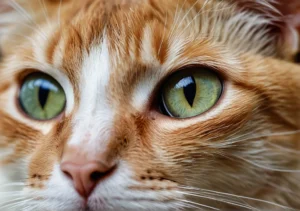Orange cats are often observed to be larger in size compared to other colored cats. This unique trait has left many cat owners wondering: why are orange cats bigger?
Genetic Factors and Size
When it comes to the size of orange cats, genetics play a significant role. Just like how you might inherit your mom’s curly hair or your dad’s green eyes, orange cats can inherit certain genes that influence their size. These genes can determine whether a cat will be large, medium, or small in size.
One interesting genetic factor to consider is the sex of the cat. Male orange cats tend to be larger than their female counterparts. This is due to the presence of the Y chromosome, which can contribute to a larger size overall. So, if you’re marveling at the biggest orange cat you’ve ever seen, chances are it’s a handsome male!
Now, genetics are complex, and there are many factors at play when it comes to determining a cat’s size. However, understanding the influence of genetic factors can give you some insight into why some orange cats are bigger than others.
Diet and Nutrition
When it comes to keeping your orange cat big and healthy, diet and nutrition play a crucial role. Just like how you might skip dessert to watch your waistline, what you feed your cat can impact their size and overall health.
Protein is essential for muscle growth and maintenance, so make sure your orange cat’s diet includes plenty of high-quality protein sources. Look for cat foods that list meat as the first ingredient to ensure your feline friend is getting the protein they need to stay big and strong.
In addition to protein, portion control is key when it comes to managing your cat’s size. Just like how you might indulge in a bag of chips if left unchecked, free-feeding can lead to overeating and potential weight gain. Be mindful of how much you’re feeding your orange cat to help them maintain a healthy size.
Remember, genetics may set the stage, but diet and nutrition can play a significant role in keeping your orange cat big and healthy. By providing a balanced diet and monitoring portion sizes, you can help your furry friend thrive.
Environmental Influences
Orange cats can grow larger due to environmental influences such as diet, exercise, and living conditions. A well-balanced diet rich in nutrients is essential for their growth. Ensure they have access to quality cat food that meets their nutritional needs. Regular exercise is also crucial to keep them healthy and prevent obesity, which can affect their size. Providing a stimulating environment with plenty of space to roam and play can contribute to their overall well-being and size. Additionally, a low-stress environment can help orange cats thrive and reach their full potential in terms of size.
Extra Tip: Environmental enrichment is key for orange cats to stay active and healthy. Consider providing toys, scratching posts, and climbing structures to keep them engaged and physically active.
Health and Well-being
The health and well-being of orange cats play a significant role in their size. Regular veterinary check-ups are essential to monitor their growth and address any health concerns promptly. Maintaining a healthy weight is crucial for orange cats to reach their full size potential. Obesity can lead to various health issues and affect their overall well-being. Provide a balanced diet and ensure they are getting enough exercise to keep them healthy and in good shape.
Additionally, genetics can also play a role in determining the size of orange cats. Some breeds may naturally be larger than others, so it’s essential to consider their breed characteristics when assessing their size potential.
Remember, proactive healthcare and proper nutrition are key to ensuring your orange cat stays healthy and grows to their full size. Prioritize their well-being to support their growth and development.
Comparison to Other Cat Breeds
When comparing orange cats to other cat breeds, you may notice that they tend to be larger in size. While size can vary depending on genetics, orange cats are often considered medium to large compared to other breeds. Breeds like Maine Coons and Siberian cats are known for their large size, and orange tabbies can sometimes match up in heft. On the other hand, Siamese and Bengal cats are typically smaller in comparison.
Gender Differences
When it comes to orange cats, there is a notable gender difference in size. Male orange cats generally tend to be larger and heavier than females of the same breed. This is due to hormonal differences, as male cats have higher levels of testosterone, which can lead to increased muscle mass and size. So, if you’re looking for a big kitty, you might want to consider getting a male orange cat.
Additional Unique Insight:
Here is a list of common cat breeds that are often larger than orange cats: – Maine Coons – Siberians – Ragdolls – Persians – British Shorthairs If you’re looking for a hefty feline companion, these breeds might be worth considering. However, keep in mind that size can vary greatly even within the same breed, so it’s essential to consider factors like genetics and individual growth when choosing a cat.
Activity Levels
Have you ever noticed that orange cats seem to be on the larger side? Well, one reason for this could be their activity levels. Orange cats tend to be more active and playful compared to other cat breeds. Their high energy levels often lead them to engage in more physical activities, such as running, jumping, and playing. This increased activity could contribute to the muscle development and overall size of orange cats, making them appear bigger than other cats.
Common Misconceptions
Despite their larger appearance, it’s essential to debunk the common misconception that orange cats are inherently bigger than other cats. The coat color of a cat does not inherently determine its size. While orange cats may seem larger due to their muscle build and activity levels, this is not a universal rule. Factors like genetics, diet, and individual health play a significant role in determining a cat’s size. So, if you have an orange cat that seems bigger than others, remember that it’s not just their color that influences their size.
Additional Insight:
- Nutrition: Providing your orange cat with a balanced diet that meets their nutritional needs can also impact their size. A diet rich in protein and essential nutrients can support healthy growth and development, contributing to their overall size. Make sure to consult with your veterinarian to ensure your orange cat is receiving the right nutrition for their size and health.
Fun Facts about Orange Cats
Orange cats are not only known for their vibrant fur but also for some interesting characteristics. Did you know that most orange cats are male? This unique trait is due to the way the orange coloring gene is linked to the X chromosome. Additionally, orange cats are often associated with warmth and friendliness, making them beloved pets in many households. They are also commonly referred to as “marmalade cats” or “ginger cats,” adding a touch of sweetness to their already charming reputation.
Unique Patterns
Orange cats can exhibit various unique patterns and markings that make them stand out. One such pattern is the “mackerel tabby” pattern commonly seen in orange cats, characterized by thin, distinct stripes running along their body. This pattern may give the illusion of these cats appearing larger than they actually are. Another interesting pattern is the “classic tabby” pattern, where swirls and bold stripes create a visually appealing look on their fur. These patterns contribute to the distinct appearance of orange cats, making them easily recognizable and admired for their individuality.
Fun Fact: Calico cats can sometimes have patches of orange fur, but true orange cats are solid-colored, further emphasizing their unique appearance.
Alex, a passionate animal lover, has experience in training and understanding animal behavior. As a proud pet parent to two dogs and three cats, he founded AnimalReport.net to share insights from animal experts and expand his knowledge of the animal kingdom.




